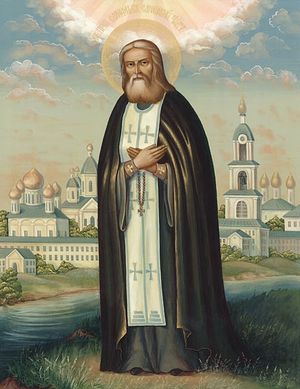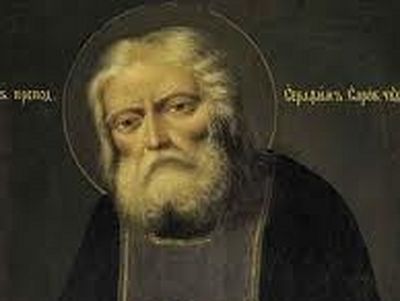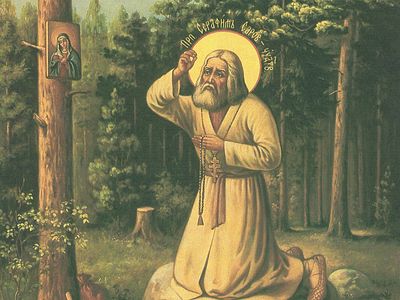1. Life of St. Seraphim Before Monasticism
St. Seraphim was born on July 19, 1759, and named after St. Prokhor, whose feast day is celebrated on the 28th day of that same month. His father’s name was Isidore, and his mother’s Agafia. His parents came from respected and wealthy merchant families. Isidore had taken up the task of building a church dedicated to St. Sergius of Radonezh, based on a design by the famous architect Rastrelli, but he died before he could complete it. He therefore conferred the task upon his wife. The young Prokhor often accompanied his mother as she supervised the church’s construction. One day he climbed with her to the top of the belfry, and slipped through the scaffolding, falling to the ground. His frightened mother was sure she would find him dead. But the words of the 90th psalm seemed clearly to guard the blessed child: For He shall give His angels charge over thee to keep thee in all thy ways. They shall bear thee up in their hands, lest thou dash thy foot against a stone. When she had descended to the ground she found the boy standing on his feet, whole and unharmed; an indubitable indication that Prokhor was under God’s special protection.
His piety in childhood was exceptional, a quality encouraged by his mother. At one time the young Prokhor had become very ill, and the Mother of God appeared to him in a dream, promising to heal him. Here is how her promise was fulfilled: a procession was passing by the house of Prohkor’s family, carrying the wonder-working Kursk Root icon of the Mother of God. When rain began to fall, the procession changed its course and passed through Prokhor’s yard. Agafia carried her sick boy to meet the miracle-working icon, and placed him under the protection of the Mother of God. From that moment the child quickly recovered.
In his younger years, Prokhor assisted his older brother in his shop, but the desire of his soul was to become a monk. His pious mother did not interfere with his soul’s yearning—she blessed him for the monastic path with a copper cross, which he never removed from around his neck until the day he died.
As a beginning, Prokhor set off with five companions to the Kiev Caves Lavra, desiring to receive the blessing of the Kiev Elders. Among the ascetics of that monastery was the famous elder Dositheus (who was found to be a woman after she died). That clairvoyant elder had been in continual contact with the blessed Elder Paisius Velichkovsky, and with those monastics who were of one mind with him. Dositheus gave Prokhor spiritual instruction, counselled him to study the ancient Holy Fathers on the work of interior prayer, and directed him to go to Sarov Monastery and remain there until death, for there he would find salvation. “Go, child of God,” Elder Dositheus said to him. “Go, and stay there. That place will be salvation unto you, with God’s help. There you will end your earthly journey. But strive to obtain a ceaseless remembrance of God through continuous calling on the name of God: “Lord Jesus Christ, Son of God, have mercy on me, a sinner.” This will be the object of all your attention and study—whether walking, sitting, or standing in the church, everywhere and in every place, entering and leaving—may this cry be ceaselessly on your lips and in your heart. In it you will find peace, attain purity of soul and body. The Holy Spirit will abide in you as a well-spring of many blessings, and it will lead your life into holiness, into great blessedness and purity. In Sarov is Abbot Pachomius of God-pleasing life—he is a follower of our Anthony and Theodosius.”
Having received his hoped-for blessing, Prokhor returned to Kursk where he stayed for two more years, after which he departed from family and worldly life with two friends, setting out upon the monastic path.
On November 20, 1776, in the evening dusk, three young pilgrims approached the gate of the Sarov bell-tower. Among them was Prokhor. That evening the All-night Vigil would be celebrated for the feast of the Entrance into the Temple of the Most Holy Theotokos. The entrance to the Sarov Dormition Church was open, and the festal All-night Vigil was beginning. Prokhor’s soul rejoiced—he had found his place.
2. Novitiate Period
On the next day the three pilgrims met with the Abbot. He received them lovingly and accepted them into the monastery. He paid particular attention to Prokhor, since he himself was from Kursk and knew the young man’s parents personally. Seeing in him the great soul of a future ascetic, he committed him for spiritual direction into the experienced hands of his co-struggler and friend, the wise and loving treasurer, Fr. Joseph. Prokhor received from him his first obedience, as cell attendant. This was only an introduction. Soon the novice Prokhor, in accordance with the general rule, was given various difficult obediences—he served in the bread and prosphora bakeries, in the furniture shop, performed the task of waking the monks, was church sacristan, sang on the cliros, and participated in the general obediences of cutting wood, maintaining the grounds, etc. Prokhor worked in the carpentry shop longer than anywhere else, where he became very experienced, and was known as “Prokhor the carpenter.”
Above all, brother Prokhor distinguished himself by his unmurmuring obedience and meticulous character, wholeheartedly carrying out all that was asked of him, as perfectly as possible. He was later to say to the Diveyevo sisters that there is no sin more deadly than murmuring, judging or being disobedient to your superiors. “Obedience is the foremost virtue, before fasting and praying.”
From his advice to monastics one can discern his own life as a novice. Second to obedience he placed labor. “If you have handiwork,” he instructed one monk, “work on it alone; if you are in your cell without any handiwork, engage in some reading, in particular the psalter. Try to read every line several times in order to concentrate it in your understanding.” He also considered reading to be a special ascetic labor, which he called “vigil.” The Gospels and the epistles of the Apostles he read before the icons, and always standing erect as in prayer. He sometimes allowed himself to read the Psalter sitting down. “Such reading produces an enlightening of the reason, which brings about a Godly change.”
After work and reading, he would instruct the novice on prayer, repeating that which was said to him by Elder Dositheus, and in which he labored ceaselessly:
“Those who have truly decided to serve the Lord God should exercise themselves in the remembrance of God, and the ceaseless prayer to Jesus Christ. In handicrafts, or anywhere on obedience,” he instructed one monk, “ceaselessly repeat the prayer: ‘Lord Jesus Christ, have mercy on me a sinner.’ Be heedful in prayer, that is, collect your mind and unite it with your soul. At first one day, then two, increasing [the labor], then saying the prayer with the mind alone, attentive to every separate word. When God warms your heart into one spirit, the prayer will flow in you without end, and will always be with you, delighting and nourishing you.… When this spiritual food in constantly within you—that is, discourse with the Lord Himself, then why go visiting the brothers’ cells, even should they invite you? Truly, I tell you that idle talk is love of idleness.”
As for sleep—he encouraged sleeping four hours (per day) from 9:00 in the evening till an hour after midnight. Similarly did he suggest restraint in eating: on Wednesdays and Fridays, especially during the four fasts, he said, “Take food once a day, and an Angel of God will cling to you.”
The Saint strongly advised to preserve peace. “Acquire peace and thousands shall be saved around you. If it is impossible not to become disturbed, then at least try to hold your tongue, according to the Psalmist: I was troubled and spake not (76:4). In order to escape judgment, you should be attentive to yourself, and ask: “Where am I?” In the same way the Saint warned about struggles with despondency: “You should throw off despondency, and strive to have a joyful spirit, not a sorrowful one, in the words of Sirach: ‘Sorrow destroys much, and there is no use for it’ (30:25). “This sickness,” the Saint said, “is healed by prayer, restraint from idle talk, handiwork as you are able, reading the Word of God and patience; because despondency arises from idleness.”
One Sarov monk was given over to such a temptation. Wishing to find relief, he shared his grief with a brother. After Vespers they left the monastery, and, walking through the surrounding area, they came to the stable. Suddenly they saw St. Seraphim. Deeply honoring him, they fell at his feet. The God-Pleaser, with extraordinary gentleness blessed them, and seeing the brother’s depression, sang out: “Fill my heart with joy, O Virgin, Thou who didst receive the fullness of joy, and didst banish the grief of sin” (troparion from the Supplicatory Canon to the Theotokos). Then, stamping the ground strongly and ecstatically, he said, “You must not sorrow, for Christ has conquered all, Adam is resurrected, Eve set free, death slain.”
Within two years after entering the monastery, Prokhor became extremely ill with dropsy. Abbot Pachomius and Elder Joseph looked after him. Seeing the sick one’s grievous condition, Abbot Pachomius proposed calling a doctor. But Prokhor asked them to provide him instead with heavenly medicine—communion of the Holy Mysteries. Elder Joseph zealously served a Vigil and Divine Liturgy for the healing of the sick one, confessed him and served him Holy Communion in his cell. After that Prokhor was quickly restored to health.
Later on, he described to many, that after Holy Communion the Most Pure Virgin appeared to him in an indescribable light with the Apostles Peter and John the Theologian, and, turning to Apostle John, said, pointing to the sick one: “He is one of our generation,” that is, of the heavenly. The Mother of God touched Her scepter to his thigh, from which water came forth. Until the end of his life a deep impression remained on his body.
In one year they began to build a large enclosure containing a church over the place where his cell was, with the church located directly over the spot where the Mother of God had appeared.
After Prokhor’s health returned he was sent out to collect donations. He was also in Kursk and happened to see his mother. But he passed his former house completely by, as his soul was already above the world.
3.In the angelic rank
At the end of the Dormition fast, August 13, 1786, Abbot Pachomius tonsured the novice Prokhor into monasticism, and named him Seraphim, which means in Hebrew “like a flame.” This name was given to him because of his fiery love for God. After this he intensified his podvig of silence. Three years later Fr. Seraphim was blessed to become a deacon and was ordained by Bishop Victor of Vladimir. The Superior rarely served without Fr. Deacon Seraphim.
Before services Fr. Seraphim would spend whole nights in prayer. At the end of the service he would remain in the church, putting the utensils in order. He would say: “Those who go to church should never say anything within it that is not necessary. And what is more beautiful, higher or glorious than a church?” He also would say: “Why can’t a man serve God at all times as do the angels?” He saw angels more than once during divine services. “Their appearance was as lightning, their clothes white like snow, or like golden cloth, their singing is impossible to describe,” he would speak of them.
An indescribable ecstasy would then overtake the Saint. “Ready is my heart,”(Ps. 56:10) he said, “as wax melteth from unspeakable joy. And I remember nothing from that joy, I remember only how I entered and left the holy church.”
One day during the Liturgy on Great Thursday, he was vouchsafed to see a vision, the likes of which very few of even the greatest saints have ever been worthy of seeing.…
“One day it so happened,” said the Saint, “that I was serving Vespers on Holy and Great Thursday. Divine Liturgy began at 2:00, as usual, with Vespers. After the lesser entrance and reading, I, the lowly one, pronounced at the royal doors: ‘Lord save the pious and harken unto us!’ Entering the royal doors and lifting my stole to the people, I finished: ‘And to the ages of ages.’ Suddenly I saw a ray of light as from the sun. Looking at this radiance, I saw Our Lord and God Jesus Christ in the image of the Son of Man, in glory and unspeakable light and brilliance, surrounded by the heavenly powers, angels and archangels, cherubim and seraphim, like a swarm of bees, coming from the west church doors as from the air.
“Approaching with such a countenance to the ambo and raising His Most Holy hands, the Lord blessed those who served and those who stood in church. He had stepped up, transfigured, to His holy icon, which was to the right of the royal doors. The surrounding angelic beings radiated unspeakable light throughout the entire church. I, earth and ashes, meeting the Lord Jesus Who stood upon the air, was deemed worthy to receive from Him a special blessing. My heart was filled with pure, holy and sweetest love for the Lord.”
St. Seraphim’s appearance changed, and stricken completely by the divine vision, he could not even move from his spot by the royal doors. Fr. Pachomius noticed, and sent two other hieromonks, who, taking him under the arms, led him to the altar. But he continued to stand there for nearly three more hours without moving, in total astonishment. Only his face changed the whole time, becoming white as snow, then flushing red.
After the divine services were over, Elder Pachomius asked him what had happened. Fr. Seraphim, who never hid anything from his spiritual fathers, related it all to them. They bid him to cloak himself in silence and to delve ever deeper into humility, to save himself from conceit that could arise from such an extraordinary vision. The Saint accepted this instruction with all meekness, and remained silent until the necessary time.
What the God-pleaser experienced during Holy Communion is known to him alone.
He gave the Diveyevo sisters the following instructions: “It is not right to forego the chance to benefit as often as possible from the blessing given through the Communion of the Holy Mysteries of Christ. Concentrate as hard as you are able, in meek awareness of your utter sinfulness and with hope and firm faith in God’s unspeakable mercy, upon approaching His Holy Mysteries by which He has redeemed all and everyone. Say with tender feeling: Forgive me my sins, O Lord, that I have committed with my soul, heart, words, deeds, and all my senses.”
Especially remarkable were St. Seraphim’s following words to Fr. Vasily, the father-confessor of the Diveyevo Convent:
“I want them to receive Christ’s Holy and Life-Giving Mysteries, Batiushka, during all the four fasts, and all the twelve major feasts. I would even like them to receive more often than on feast days alone; the more often the better.
“You are their father-confessor—do not prohibit them, I say to you. For the gift of Holy Communion is so great, that even though a person be sinful, he may, with humility and awareness of his sinfulness only, approach the Lord who has redeemed us all. And though he be covered with festering sins from head to toe, he will be cleansed, Batiushka, by Christ’s blessing, and will become lighter and lighter, until he is completely enlightened and is saved. There, Batiushka, you are their father-confessor, and I tell you all this so that you will know.”
However, Fr. Seraphim cautioned: “If they approach without sufficient repentance, it sometimes happens thus: on earth they have received Communion, but with the Lord they have not communed. He who reverently receives the Holy Mysteries more than once a year will be saved, happy, and live long upon the earth. I believe,” he added, “that by God’s great mercy he and all his kin shall be marked with grace. One man who performs God’s will is greater in God’s eyes than many lawless ones.”
In 1789 Abbot Pachomius, the treasurer Isaiah, and Hierodeacon Seraphim visited Blessed Agafia Semyonovna Melgunova, in monasticism Mother Alexandra. Having received a warning from God that her life was near its end, she asked of Fr. Pachomius that he not abandon the sisters. Fr. Pachomius answered that he himself was not long for this earth, “But here is Hierodeacon Seraphim—his spirituality is already well-known, and he is young. Give the job to him.”
Mother Alexandra said that she could only ask, but it is the Heavenly Queen Herself who would give him this duty.
In this way was St. Seraphim given the Diveyevo Convent, which he later directed to the last detail of its life, although the Convent was located seven miles from Sarov, and he never even once went there personally.*
Seven years had passed from the time Fr. Seraphim was tonsured into monasticism and four years since his ordination as a deacon. Fr. Pachomius grew nearer to death, and wished to see Fr. Seraphim in full priestly glory. On September 2, 1793, he was ordained by Bishop Theophilus of Tambov. The years that had led St. Seraphim to the staff of God ignited in him a fiery thirst to leave for the desert. His mentors were leaving one after the other for a better world. Fr. Joseph, his first elder, left long ago. Fr. Pachomius, who loved him fervently, was preparing to depart. Fr. Seraphim looked after him, and gave him his word to care for the Diveyevo sisters. Fr. Pachomius was overjoyed and kissed him. After that, he peacefully departed to God. Having cried over his friend and benefactor, Fr. Seraphim requested permission from the new abbot, Fr. Isaiah, to depart for the hermitage, and he received written permission. This was again on the feast of the Entrance into the Temple of the Most Pure Mother of God, November 20. On this day, sixteen years before, the young Prokhor had stepped through the monastery gates. Now, with a flaming soul Fr. Seraphim stepped through them in the other direction—not into the world, but deep into the desert. The Mother of God knew him, and sent him into the Holy of Holies, closer to Herself and to God.
From St. Seraphim Wonderworker of Sarov and His Spiritual Heritage by Helen Kontsevich (St. Xenia Skete)







